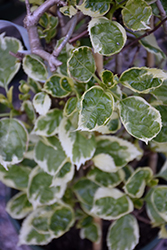It's all about ...
plants

Lacy Hearts™ Japanese Hydrangea Vine
Schizophragma elliptifolium 'MonHart'
Height: 15 feet
Spread: 24 inches
Sunlight:
![]()
![]()
Hardiness Zone: 6b
Other Names: Climbing Hydrangea Vine
Brand: Monrovia
Description:
One of the most sought-after climbers, this vine produces shimmering heart shaped leaves splashed with creamy white; often accented with hydrangea-like lace cap blooms in mid summer; a self-clinging vine with showy foliage when not in bloom
Ornamental Features
Lacy Hearts™ Japanese Hydrangea Vine is clothed in stunning cymes of lightly-scented white flowers along the branches from early to mid summer. It has creamy white-variegated forest green foliage with hints of grayish green. The glossy heart-shaped leaves turn yellow in fall. The peeling brown bark adds an interesting dimension to the landscape.
Landscape Attributes
Lacy Hearts™ Japanese Hydrangea Vine is a multi-stemmed deciduous woody vine with a twining and trailing habit of growth. Its relatively coarse texture can be used to stand it apart from other landscape plants with finer foliage.
This woody vine will require occasional maintenance and upkeep, and is best pruned in late winter once the threat of extreme cold has passed. It has no significant negative characteristics.
Lacy Hearts™ Japanese Hydrangea Vine is recommended for the following landscape applications;
- Hedges/Screening
- General Garden Use
Planting & Growing
Lacy Hearts™ Japanese Hydrangea Vine will grow to be about 15 feet tall at maturity, with a spread of 24 inches. As a climbing vine, it tends to be leggy near the base and should be underplanted with low-growing facer plants. It should be planted near a fence, trellis or other landscape structure where it can be trained to grow upwards on it, or allowed to trail off a retaining wall or slope. It grows at a slow rate, and under ideal conditions can be expected to live for 40 years or more.
This woody vine does best in partial shade to shade. It does best in average to evenly moist conditions, but will not tolerate standing water. It is not particular as to soil pH, but grows best in rich soils. It is somewhat tolerant of urban pollution, and will benefit from being planted in a relatively sheltered location. Consider applying a thick mulch around the root zone in winter to protect it in exposed locations or colder microclimates. This is a selected variety of a species not originally from North America.
This plant is not reliably hardy in our region, and certain restrictions may apply; contact the store for more information.
